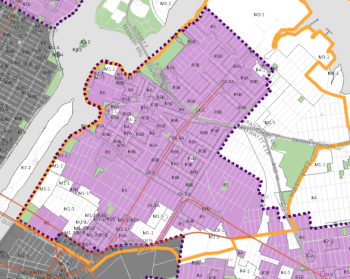
Gerald Caliendo, acting chair of Zoning Committee
Nov. 11, 2015 By Christian Murray
The City’s push to amend the zoning code as a means to promote the construction of affordable housing was approved by Community Board 1 last night subject to a number of conditions.
The Board took issue with several elements in the proposed amendments, such as the elimination of parking space requirements for affordable housing units within a half mile of a subway station, as well as the potential for small-scale developers to get out of constructing affordable units at all.
The board voted on two amendments and overwhelmingly approved them both, but with a number of stipulations.
One amendment, called Zoning for Quality and Affordability, largely deals with increased building heights and the elimination of the parking spaces currently required for affordable units and affordable senior units located near mass transit.
Within a large swath of Astoria, the ZQA amendment would allow buildings to stretch five feet higher than current regulations allow. The extra five feet would have to be applied to the ground floor space, which would essentially lead to bigger residential lobby areas or larger ground floor retail space.
The height increase, according to the Dept. of City Planning, is intended to give builders more flexibility within existing zoning rules, to encourage new housing construction with more engaging architecture.
Tom Ryan, a member of the zoning committee who reviewed the amendments in depth, said after the meeting that he liked the concept of allowing 5 additional feet to the ground floor. He said it would be good for retailers
Similar tweaks to zoning rules, permitted by the ZQA, would incentivize affordable senior housing in the neighborhood.
Developers who build affordable senior homes along Steinway Street, in central Astoria and in a portion of Ditmars, could build 10 or 20 feet higher than currently allowed, depending on zoning district. In a wider chunk of the district, certain types of senior housing and long term care facilities would also be allowed greater height and floor area.
The Board did not take issue with these height changes and did not address them in its list of conditions.

Shaded area: where parking requirements would be eliminated for affordable and senior housing
The elimination of parking requirements at affordable and senior housing—which would apply throughout much of Astoria—generated the greatest concern.
DCP argues that in areas such as Astoria, where public transportation is available, low-income and senior households own fewer cars and the off-street parking provided to them goes to waste.
By removing the requirement, DCP said, it will remove an unnecessary cost to affordable housing developers.
The board disagreed and made it a condition that the existing parking requirements remain when it approved the ZQA amendment.
“We think the vast majority of people still have cars,” said Gerald Caliendo, who was acting as chair of the zoning committee. “Many seniors also have cars. I’m 60 and I have a car.”
DCP’s other zoning amendment, called Mandatory Inclusionary Housing, would require that new developments of more than 10 units include 25 or 30 percent permanently affordable housing when a rezoning to increase housing capacity occurs.
Therefore, if a private developer built a residential tower in Astoria, and asked the City for a rezoning of the property to permit construction of more units, MIH would be triggered.
Developers are not required to put the affordable apartments in the same building as the market-rate apartments. Instead, they can build them in a separate building in another part of the community board district or within half a mile from market-rate development.
However, buildings with between 10 to 25 units would be able to pay into a fund in lieu of the affordable apartments.
CB 1 took issue with the structure of the fund.
The Board believes that the payment in lieu of building units for smaller developments does not support the City’s goals to preserve economically diverse neighborhoods. It said that the payment option encourages higher density, market rate developments.
Ultimately, the Board approved the MIH amendment on the condition that the City provides greater clarification as to how the payment in lieu funds would be spent, and assurances that they would be put into the same community board district as the associated market rate development.
The Board also approved MIH on the condition that any rezoning be accompanied by an upgrade in infrastructure, such as schools, utilities or mass transit.
Another condition touched on the broader issue of affordability. CB 1 said rent levels for affordable housing in Astoria must be based on local income levels. Therefore the Board wants the City to calculate affordability based on the relevant community board, as opposed to Citywide data, as it currently does.
Queens Borough President Melinda Katz will host a meeting with the heads of all Queens community boards on Monday to vote on MIH and ZQA.
qn01 by Queens Post
.
Mih Presentation 0915 by Queens Post
One Comment

The construction of affordable housing was overwhelmingly rejected by Community Board 2. Why did Community Board 1 approve? I guess CB1 cared about preserving peoples home values, building aesthetics and not interfering with their current real estate boom and rentals.